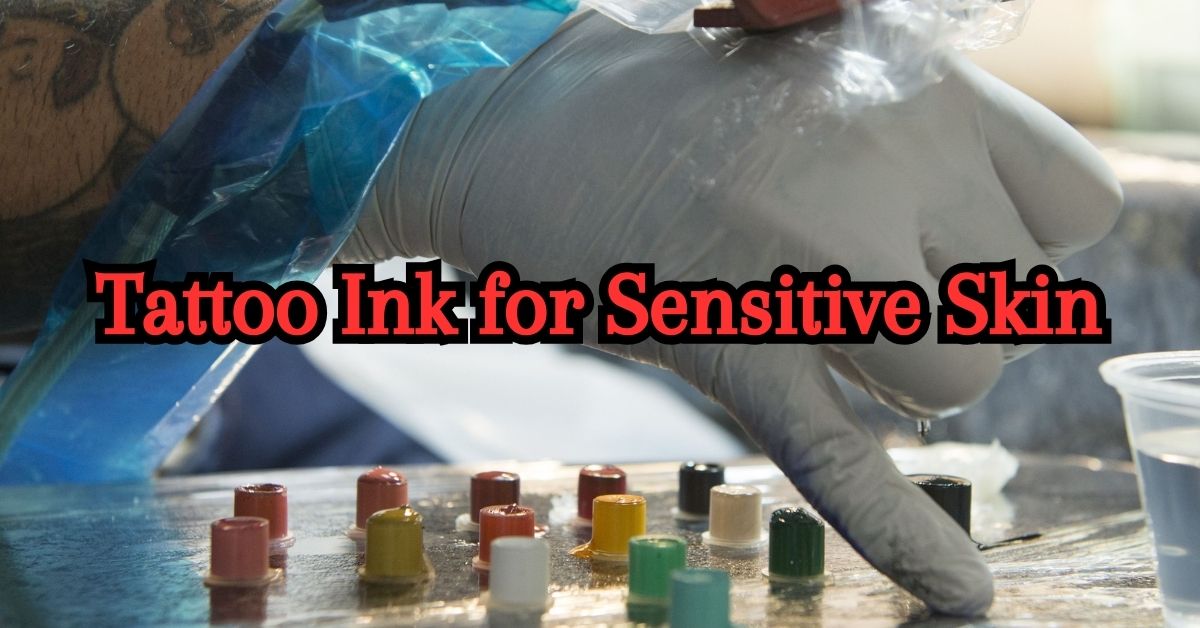Introduction
Getting a tattoo can be an exciting way to express your unique self. However, finding the right tattoo ink is absolutely crucial if you have sensitive skin. The wrong ink ingredients can cause extremely painful, long-lasting reactions and skin damage for those with sensitive complexions. Luckily, there are kinder and safer tattoo ink options specifically designed with sensitive skin in mind.
In this comprehensive guide, we’ll explore everything you need to know about picking the best tattoo ink for sensitive skin. We’ll discuss what makes skin reactive, problematic ingredients to avoid at all costs, how to choose compatible ink brands, proper aftercare, and much more. By the end, you’ll understand how to safely decorate your sensitive skin with incredible tattoo artwork.
Also, here will walk you through everything you need to know about choosing non-irritating tattoo inks and getting tattooed safely if you have sensitive skin. We’ll discuss:
- What makes some skin more sensitive than others
- Problematic ingredients to avoid at all costs
- How to select the most compatible tattoo ink brands
- Tips for prepping skin before getting a tattoo
- Finding an experienced tattoo artist
- Caring for new tattoos properly during healing
- What to do if you still experience a reaction
- FAQs about tattoos and sensitive skin
By the end, you’ll understand how to get incredible tattoo results without redness, swelling, itching, or other complications. Let’s start by understanding the factors that make skin reactive.
What Contributes to Sensitive Skin?
Sensitive skin is more common than you may think – research shows over 50% of women and 40% of men identify as having easily irritated, reactive skin. Certain factors make someone more predisposed to skin sensitivities and allergies:
Genetic Predisposition
Experts believe genetics play a major role in sensitive skin. If your parents have easily irritated skin, you likely inherited similar traits. fair, pale skin with a tendency to blush/flush easily is a telltale sign. Those of Celtic, Scandinavian, or Asian descent often have the most sensitive skin types.
Skin Conditions
Medical conditions affecting the skin also increase reactivity. Eczema, psoriasis, rosacea, acne, and vitiligo all make skin more vulnerable to external irritants. Damaged skin barriers allow allergens to penetrate and trigger inflammation more easily.
Autoimmune Disorders
Autoimmune diseases like rheumatoid arthritis, lupus, and multiple sclerosis cause widespread systemic inflammation, lowering the skin’s tolerance for irritants. The immune system attacks harmless compounds, so reactions are more likely.
Allergies and Asthma
Those with allergies and asthma have overactive immune responses to many environmental and chemical triggers. Their skin mast cells release more histamine, making them prone to skin reactions as well. Allergies to metals, scents, and certain foods can indicate risks of sensitivity to tattoo inks.
Age
Younger and older age groups tend to have more easily irritated skin. Children’s and seniors’ skin is more fragile with less fatty protective tissue and decreased collagen levels. Teens also undergo hormonal changes that amplify skin reactivity.
Previous Reactions
If you’ve reacted to hair dyes, makeup, skincare products, jewelry metals, or other items before, you may be vulnerable to the same ingredients in tattoo inks. Nickel, cobalt, and red pigments are common culprits.
Medications
Certain medications like anxiety medications, blood pressure prescriptions, and oral steroids impact immune functioning and collagen formation, making skin more permeable and sensitive. Large doses or multiple medications compound risks.
Overall Health
Skin needs key nutrients to maintain its protective barrier. Diets lacking vitamins A, C, D, E, zinc, and essential fatty acids impair optimal skin immunity and healing. Chronic stress also stunts skin health and amplifies sensitivity.
Location on the Body
Areas with less fatty padding and more nerve endings feel irritation and pain more acutely. These high sensitivity zones include the hands, feet, ankles, ribs, and areas over bone prominences and joints. Ink here requires extra precaution.
As you can see, many interconnected factors determine your overall skin sensitivity and resilience. Now let’s explore specific tattoo ink ingredients to avoid.
Problematic Tattoo Ink Ingredients
Tattoo inks contain pigments suspended in a carrier solution along with stabilizers and preservatives for longevity. However, some common ingredients provoke skin inflammation, especially for those with sensitivities:
Formaldehyde
Added to prevent bacterial growth, this preservative is a known human carcinogen banned in cosmetics in the EU. It can cause severe contact dermatitis and allergic reactions when absorbed into newly tattooed skin.
Para-Phenylenediamine (PPD)
PPD is a chemical dye in hair colorings, textile manufacturing, and temporary “black henna” tattoos. It is extremely allergenic for many people, causing redness, blistering, scarring, and permanent sensitivity when used in permanent tattoos.
Isopropyl Alcohol
This disinfecting alcohol irritates freshly wounded skin from tattooing. It stings intensely and dries out skin, delaying healing. It should only be used on sterile equipment, not directly on the skin.
Polyethylene Glycol (PEG)
PEGs are petroleum-derived compounds used as thickening agents in tattoo inks. However, they are common sensitizers that can trigger red, scaly rashes and inflammation during healing.
Glycerin
Added as a stabilizer, glycerin draws moisture out of skin. This leads to dryness, itching, cracking, and prolonged healing time. Glycerin has no benefits for tattoo skin health.
Fragrance
Artificial perfumes smell nice but provide zero skin benefits. Fragrances are among the most common sources of allergic contact dermatitis. Healing skin absorbs these unnecessary chemicals readily.
Glutaraldehyde
Used to sterilize some tattoo inks, this chemical can leach into skin. It’s known to cause asthma attacks, headaches, rashes, and breathing issues when absorbed into the body.
Nickel and Chromium
Metallic contaminants like nickel and chromium from low-grade tattoo ink pigments are common instigators of painful swelling, oozing, and persistent reactions, especially around red and black shades.
Recommended Tattoo Inks for Sensitive Skin
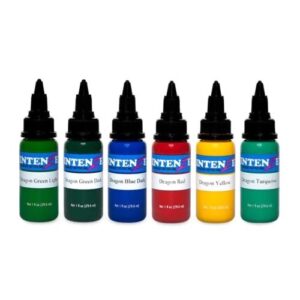
To avoid these problematic ingredients, seek out high-quality inks using gentler formulas specially created with finicky skin in mind:
Intenze Tattoo Ink
Renowned industry leader Intenze handcrafts their ink in small batches for unparalleled purity. Their Zuper Black ink avoids common allergens and uses iron oxide pigments for soft application. Intenze does intensive compatibility testing with sensitive skin clients.
Millennium Moms Tattoo Inks
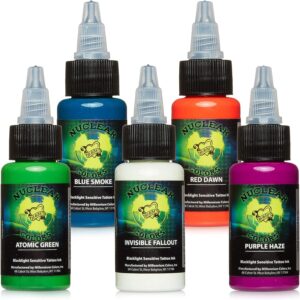
As the name implies, these vegan and cruelty-free inks are designed for expecting and nursing moms with shifted skin needs. Their Low Irritant line features purified plant-based pigments less likely to cause reactions.
Dynamic Color Tattoo Inks

Dynamic Color uses finely ground organic pigments with no synthetic preservatives or colorants. Their specially mixed lighter shade inks work well for hands, feet, and fading-prone spots on sensitive skin.
Radiant Colors Tattoo Ink
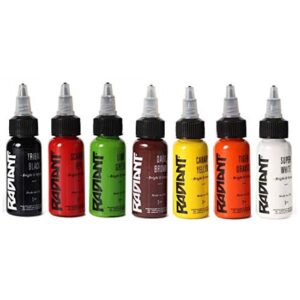
Radiant Colors adds skin-nourishing ingredients like aloe, shea butter, and calendula extract to their premium ink. This enhances flow and soothes irritation-prone complexions during healing.
Kuro Sumi Tattoo Colors
This Japanese brand filters their inks extensively to remove potential irritants and stabilize pigments. Clients praise their dynamic color palette and smooth application on sensitive Asian skin types.
Prick Tattoo Ink
Based in Sweden, Prick handmakes natural vegan inks using raw ingredients like chamomile, olive oil, acai, and charcoal for gentle formulations. Their inks are nicely pigmented without harsh chemicals.
Arcane Tattoo Inks
Arcane triple filters their inks to remove impurities and ensure ultra-fine, consistent pigments. Their Gentle Line features ingredients like jojoba, sunflower, and green tea to actively nourish skin.
Mario Barth Tattoo Ink
Celebrity tattoo artist Mario Barth makes his own sensitive skin-friendly ink line with soothing calendula extract. Light trace amounts of metals and preservatives minimize risks.
How to Prep Skin Before Getting a Tattoo
Once you’ve chosen compatible ink, prepare your skin proactively before tattoo day:
Patch Test Inks
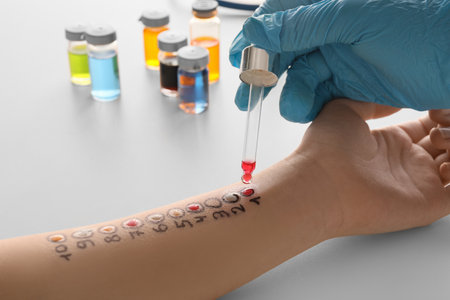
Apply a dime-sized ink blot to your skin and cover it for 24-48 hours a few weeks beforehand. If any excessive itching, burning, or redness results, avoid that ink. This identifies problem pigments or ingredients you could react to.
Exfoliate Gently
Use a soft washcloth or gentle sugar/coffee scrub a few times a week on your planned tattoo area. This removes dead cells and maximizes smoothness for clean ink absorption.
Moisturize Daily
Keep skin hydrated but not greasy leading up to appointments. Hydration supports faster healing. Avoid new products that may cause unexpected breakouts or reactions.
Avoid Irritants
Stop waxing, bleaching, or using acne products on skin weeks before tattooing. Hair removal and harsh chemicals compromise the skin barrier.
Shave Carefully
If shaving your tattoo area, do so at least 3 days pre-appointment to avoid raw, irritated skin. Use a clean razor with a fresh sharp blade plus moisturizing shave gel.
Eat Skin-Nourishing Foods
Load up on antioxidants, essential fatty acids, vitamins, and minerals from fruits, vegetables, nuts, seeds, and lean proteins. Avoid processed junk food.
Minimize Stress
Chronic stress delays wound healing significantly. Do relaxing activities like yoga, reading, hobbies, and spending time outdoors before appointments to set the optimal healing tone.
Choose an Experienced Artist
An expert tattoo artist accustomed to working with sensitive skin can make a tremendous difference in your results. Avoid scratchers. Look for these traits:
Extensive Tattoo Portfolio
Ask to see healed photos of their work, especially with finicky skin tones. Ensure they have experience with your desired style and tattoo locations.
Strong References
Talk with former sensitive skin clients about their experiences. Look for proof of healed sensitive skin tattoos without major complications.
Uses Gentle Techniques
They should move slowly, listen to your feedback about pain levels, and offer breaks as needed. Heavy-handed artists can traumatize the skin.
Proper Sanitation
The shop and artist must follow autoclave equipment sterilization, fresh needle/tube practices, handwashing, glove use, and disinfection protocols to avoid infections.
Personal Service
A quality artist will patiently discuss your skin concerns, offer advice about best ink colors and aftercare, and address any questions respectfully.
Ongoing Support
They should provide contact information if any post-healing issues arise and request follow-ups on your results.
Caring for New Tattoos on Sensitive Skin
Proper aftercare is crucial for avoiding irritations and helping sensitive skin heal optimally. Follow these tips:
Leave Bandages On
Keep original bandages on a minimum of 2 hours to allow plasma and fluids to form the first protective layer. Allow the artist to remove them.
Hands Off
Don’t pick scabs or scratch new tattoos. This can pull out ink and lead to patchy spots, especially on delicate thin-skinned areas.
Clean Twice Daily
Gently cleanse tattoos using a mild, fragrance-free liquid soap to remove bodily fluids and plasma. Let the tattoo fully air dry afterward.
Apply Thin Moisturizer Layer
Use a few drops of a mild, fragrance-free lotion after cleansing to keep the tattooed area supple without oversaturation. Ointments can block oxygen from reaching the skin.
Avoid Direct Sun
Keep new tattoos completely covered outdoors and use SPF 30 sunscreen after they fully heal. The sun can still damage and fade tattoos over time.
Wear Loose Clothing
Tight clothing rubs against tender healing skin. Opt for loose breathable fabrics against your tattoo like soft cotton.
Stop Smoking
Smoking seriously slows healing by restricting blood flow. If possible, avoid smoking until tattoos are healed. The toxins also break down pigments over time.
Wait to Swim/Soak
Avoid pools, hot tubs, baths, and other immersion in water for a minimum of 2 weeks until tattoos form a protective layer and lose their initial open wound status.
Watch for Signs of Infection
Diverse symptoms like spreading redness, worsening pain, heat, fever and discharge can indicate an infected tattoo. Seek medical treatment promptly to avoid permanent damage.
How to Treat a Tattoo Reaction
Even with the right methods and precautions, some sensitive individuals still react during healing. Here is how to treat flare ups:
Seek Medical Guidance
Severe reactions with blistering, oozing, or spreading redness may require prescription oral/topical antibiotics or steroids. Follow your doctor’s instructions closely to resolve infections.
Use Anti-Itch Creams
For mild itching and swelling, hydrocortisone creams and antihistamines provide relief without damaging healing skin further with scratching.
Avoid Re-Exposure
Don’t attempt cover-ups or additional tattoos with inks that previously caused reactions until the initial tattoo heals fully. This could worsen the reaction.
Report to Your Artist
Notify your tattoo artist about any adverse effects so they can log the issue and help figure out which ink ingredients to avoid for you moving forward.
Consider Removal
In rare cases of severe allergic reactions, the tattoo may need complete removal after healing. Talk with a dermatologist about removal options like laser treatments to break down the source of the sensitivity.
Go Slow With More Tattoos
Wait 6-12 months after healing before attempting any new tattoos in different locations. Consider starting with very small designs to test your skin’s tolerance again.
Frequently Asked Questions About Tattoo Ink for Sensitive Skin
Here are answers to some commonly asked questions about getting tattooed safely with easily irritated skin:
How long do tattoo reactions take to show up?
Most reactions appear within the first 1-2 weeks as the skin goes through the inflammation and healing process. Redness lasting longer than a few days is a sign of sensitivity. Delayed reactions are uncommon but can occur up to months later in some cases.
What’s the best place on the body to get a tattoo for sensitive skin?
Areas with thicker skin and more padding like the upper arms, shoulders, thighs, and back tend to have the least sensitivity and healing issues. Avoid bony prominences like wrists, hands, feet, ankles, and chest.
Should I avoid getting tattooed in summer if I have sensitive skin?
Excessive sun and sweating during summer can interfere with healing for those prone to reactions. However, take proper sun precautions and keep the areas clean to compensate. The winter months are ideal for getting new tattoos.
Can tattoo numbing creams reduce risks of reactions?
No, numbing creams only constrict blood vessels and dull nerve endings temporarily. They don’t affect actual skin sensitivity or inflammation levels. Plus, they introduce additional chemicals into the skin.
How can I find hypoallergenic red tattoo ink that’s less reactive?
There are a few specialty ink brands that reformulate red pigments to remove potential allergens like cadmium and mercury. Intenze and Radiant Colors offer pure, low-irritation red shades suitable for finicky skin.
Should I get a allergy test for tattoo inks before getting one?
Patch testing specific inks on your skin before full application is wise to check for any reactions. However, medically administered intradermal allergy testing for tattoos is still relatively experimental and not widely available.
Conclusion
With meticulous planning and communication, those with easily irritated skin can enjoy stunning tattoo art free of adverse reactions. Carefully research and select tattoo artists experienced working with sensitive skin clients. Invest time finding the purest tattoo inks using natural, low-irritant pigments and formulations made for finicky complexions. Employ proper sanitary practices and aftercare of your new tattoos. Start slowly with concealed small designs and less reactive body areas as you gauge your own skin’s tolerance. While it requires patience and diligence, tattooing sensitively doesn’t have to be an exercise in frustration.
